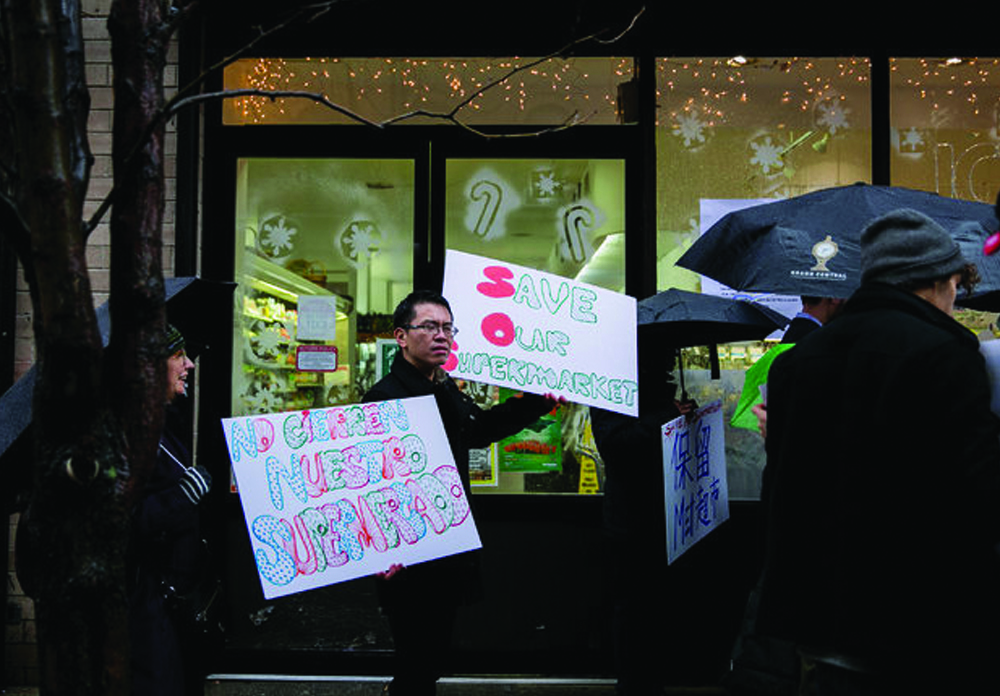SoHo offers a bounty of food — each block in this Manhattan neighborhood seems to feature artisanal chocolatiers selling single origin cacao, juice shops extruding vegetables for $9 a bottle and stores peddling cupcakes and Cronuts. Yet while high-end delicacies with gold bullion prices abound, humbler places to buy a jar of nonartisanal peanut butter or a sack of plain old gluten-full flour are much harder to find.
And on New Year’s Eve at 9 p.m., SoHo will get more difficult for residents without Fresh Direct accounts or Dean & DeLuca-size wallets when Met Food, a neighborhood stalwart for more than four decades, closes its doors on Mulberry Street and shuts for good. According to its owner, Paul Fernandez, he was unable to agree to new lease terms with the landlord. Over Met Food’s 25 years at its Mulberry Street location, the store’s rent has risen to $90,000 a month from $9,000.
In a neighborhood bursting with food, the closing, residents say, leaves a hole for lower-income and longtime residents whose means have not changed as the neighborhood has gone over the decades from a homely enclave to a glamorous address. For the market’s employees — some of whom have watched their predominantly working- and middle-class customers grow up in the aisles of Met Food — and for the store’s regular shoppers, the shutdown is yet another moment in which the ever-gentrifying city becomes that much less livable.
“New York has become very upscale on every corner of the island,” Mr. Fernandez said, “and something has to give at some point, but apparently that time has not come.”
Mr. Fernandez said he had wanted to continue to lease the ground-floor market at the $90,000-a-month rate, but at that price he could not also afford to remodel and update the antiquated freezer cases and cashier lanes, as his landlord had asked and he agreed was necessary. He envisioned a hybrid market. Perhaps a section of upscale goods like goji berries, bison burgers and recycled toilet paper alongside a more down-home selection of everyday staples. While he was offered a brief extension on the lease, he said, he could not invest in needed updates for such a short term.
An email and a telephone call to the landlord, Abington Properties, were not returned.
Despite complaints, SoHo is far from the kind of so-called food desert that has become a continuing problem in many predominantly low-income neighborhoods across the city. The Department of City Planning has measurements to determine how accessible supermarkets are in a given neighborhood. According to a 2016 report issued by the city, SoHo is slightly under the ideal, but it is in far better shape than other areas, like South Brooklyn.
But residents say the measure misses a key factor: Much of SoHo’s food bounty, like that from Whole Foods and gourmet markets, is out of reach for some older residents and others with limited means, many of whom live in rent-controlled or -stabilized apartments in the area. The closing of Met Foods, where, workers say, longtime shoppers sometimes would buy mushrooms and return with trays of Italian stuffed mushrooms for the employees to sample, seems to them another turn of the screw, where ratcheting affluence continues to make New York City less habitable.
“This is where people run to get their milk and their veggies,” said Margo Lakin, 48, who works in marketing and lives on Broome Street. On Thursday, she stood in the rain with about a dozen residents and elected officials in front of Met Food chanting “Save our supermarket!” and holding signs bearing a similar slogan in Chinese, Spanish and English. “It’s not a food desert if you have the money and the means to get around, but for a lot of people in this neighborhood it is.”
It is a refrain similar to that heard here this year when a BP gas station on Houston Street closed in April to make way for an upscale office building, leaving the lower half of Manhattan without a single gas station.
“The shoe repair, the little stores that give you your day-to-day necessities, are all going away in favor of chain stores and flagship stores, but yet people still need to buy groceries,” said Terri Cude, the chairwoman of Community Board 2, which represents the area. “When every bit of open space is considered a development site and every bit of local retail is considered not enough of a moneymaker, then it seems to me you can lose what makes a neighborhood easy and pleasant and possible to live in.”
Margaret Chin, the city councilwoman who represents the neighborhood, said she had been blindsided by the decision to close the market because she had received assurances from a representative of the shop months before that it would stay open. After being informed by a reporter of the planned closing on Saturday, Ms. Chin and other local elected officials, State Senator Daniel L. Squadron and Assemblywoman Deborah J. Glick, wrote a letter to the landlord condemning the decision.
“Particularly troubling to us and the community at large is the desire for ‘a more upscale operation’ given as a factor by your firm for its decision to end lease negotiations to keep this essential low-cost neighborhood food market open,” the letter said.
Answering phones near the checkout counter a few days before the store’s final day, Vian Alvarez, 46, the office manager, reflected on his 18 years working at the market. The store’s 30 employees have been assured that they will have jobs at another Met Food in the nearby Chelsea neighborhood. But to Mr. Alvarez, the loss still loomed large.
“The working class, the people that move the city, is moving away from this city,” he said. If that happens, he said, “I don’t know what will happen to the city.”
Article By: The New York Times

